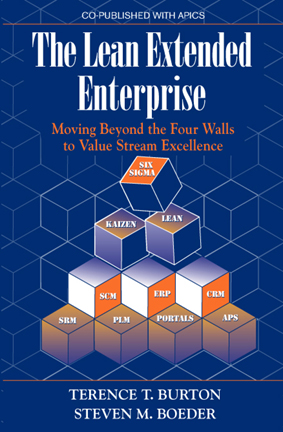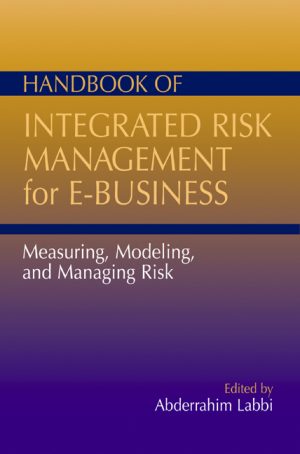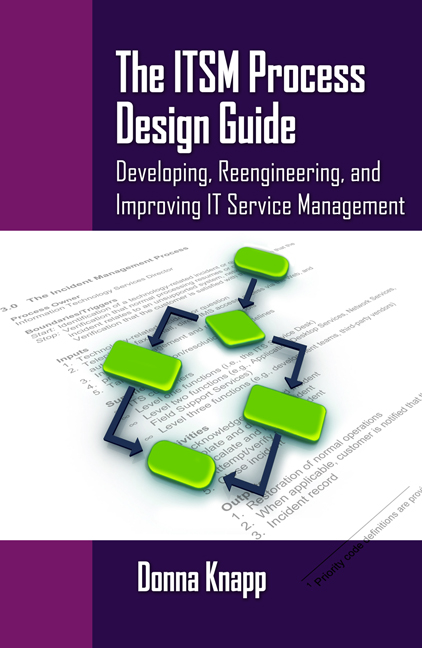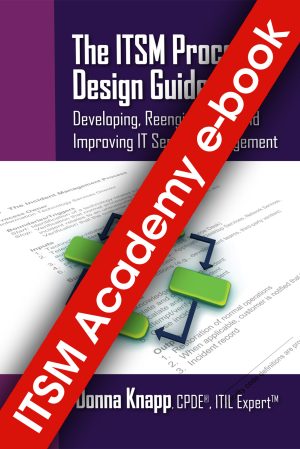The ITSM Process Design Guide
$69.95
Developing, Reengineering, and Improving IT Service Management
By Donna Knapp, CPDE, ITIL ExpertTM
Softcover, 6 x 9, 248 pages
ISBN: 978-1-60427-049-5
August 2010
Description
The Definitive Source for Certified Process Design Engineers
IT organizations increasingly recognize the need to design, re-design, and improve their internal IT service management (ITSM) processes. While popular frameworks such as the IT Infrastructure Library™ (ITIL®), Control Objectives for IT (COBIT®), Microsoft® Operations Framework (MOF), and the ISO/IEC 20000 standard describe what to do, they do not describe the mechanics of how to do it. The ITSM Process Design Guide: Developing, Rengineering and Improving IT Service Management closes the knowledge gap by providing detailed guidance on assessing, designing, measuring, and integrating ITSM processes. The advice and techniques in this book apply unilaterally to every IT service provider and ITSM framework, standard, and maturity model. While other books may touch on process design methods and techniques, there is no other publication dedicated specifically to developing, re-engineering and improving ITSM processes.
This guide is also the definitive reference source for the Certified Process Design Engineer (CPDE®) qualification. The CPDE qualification imparts and validates knowledge of best practices in the assessment, design, integration, implementation, and management of ITSM processes. It recognizes the value of having a qualified CPDE within an organization and has been endorsed by The APM Group (ITIL’s official accreditor) as a complementary qualification for the ITIL Qualification Scheme.
Key Features
- Fosters the understanding and integration of multiple ITSM frameworks, standards, and maturity models
- Details and deconstructs ITSM process components, models, and deliverables
- Includes strategies for gathering and analyzing process requirements to aid in analyzing and improving processes
- Shows how to engage process stakeholders and incorporate ITSM best practices into your organization
- Contains a methodology for developing meaningful metrics for your organization and ways to convert data into usable, actionable information
- Includes proven ways to manage the organizational culture change required for continual process improvement
About the author(s)
Donna Knapp is a Certified Process Design Engineer (CPDE)® with over 25 years of experience in the IT industry. Donna holds multiple ITSM certifications including: ITIL Expert™, ITIL® Service Manager, and various ITIL® Intermediate and Capability certifications. Donna was one of the first globally to achieve the ITIL Expert™ and Certified Process Design Engineer (CPDE)® certifications. She also holds the ISO/IEC 20000 Foundation and Consultant Certificates, and the Microsoft® Operations Framework (MOF) Foundation Certificate.
Donna serves as ITSM Academy’s Curriculum Development Manager, sits on the ITIL® V3 International Examination Panel, and is the author of two textbooks: A Guide to Service Desk Concepts, Third Edition and A Guide to Customer Service Skills for the Service Desk Professional, Third Edition. She is also the author of the highly successful seminar “Achieving High Customer Satisfaction: Customer Service Skills for the Service Desk Professional.”
Donna’s background includes working as a practitioner, consultant, and trainer, and she brings to every engagement her practical experience and knowledge of ITSM topics. She is known as an entertaining, informative and sought-after speaker and seeks to promote the processes and best practices required to deliver high-quality customer support and IT services.
Table of Contents
Chapter 1: Introduction
1.1 The Changing Role of IT
1.2 The Importance of IT Service Management Processes
1.3 Using Process Frameworks and Standards
1.4 IT Service Management Frameworks
1.4.1 Complementary Frameworks
1.5 IT Service Management Standard – ISO/IEC 20000
1.6 The Value Chain and Its Effect on Processes
1.7 Assessing Process Maturity
Summary
Discussion Topics
Review Questions
Chapter 2: Defining and Analyzing Customer Requirements
2.1 Gathering Requirements
2.1.1 Surveying Customers
2.1.2 Conducting a Needs Assessment
2.1.3 Creating and Using Service Level Agreements
2.1.4 Benchmarking
2.2 Translating Customer Requirements
Summary
Discussion Topics
Review Questions
Chapter 3: Quality Management Principles
3.1 Quality Management Basics
3.1.1 Total Quality Management
3.1.2 Malcolm Baldrige National Quality Award
3.1.3 Capability Maturity Model® Integration
3.1.4 Six Sigma
3.1.5 Lean Six Sigma
3.1.6 ISO 9000 and ISO 9001
3.2 Process Design Considerations
3.2.1 Developing Processes
3.2.2 Reengineering Processes
3.2.3 Improving Processes
Summary
Discussion Topics
Review Questions
Chapter 4: Defining and Documenting Processes
4.1 Distinguishing Policies, Processes, Procedures, and Plans
Summary
Discussion Topics
Review Questions
Chapter 5: Assessing Process Maturity
5.1 Getting Started
5.2 Assessing Incident Management Maturity
5.2.1 Level 1 (Initial): Characteristics
5.2.2 Level 1 (Initial): Challenges and Transition Steps
5.2.3 Level 2 (Repeatable): Characteristics
5.2.4 Level 2 (Repeatable): Challenges and Transition Steps
5.2.5 Level 3 (Defined): Characteristics
5.2.6 Level 3 (Defined): Challenges and Transition Steps
5.2.7 Level 4 (Managed): Characteristics
5.2.8 Level 4 (Managed): Challenges and Transition Steps
5.2.9 Level 5 (Optimizing): Characteristics
5.2.10 Level 5 (Optimizing): Challenges and Transition Steps
Summary
Discussion Topics
Review Questions
Chapter 6: Process Design and Improvement Steps
6.1 Step 1: Determine Management’s Vision and Level of Commitment
6.2 Step 2: Establish a Project and Form a Project Team
6.3 Step 3: Define the Process and Identify Customer Requirements
6.4 Step 4: Document the “As Is” Process and Baseline Current Performance
6.5 Step 5: Assess Conformance to Customer Requirements
6.6 Step 6: Benchmark Current Performance
6.7 Step 7: Design or Redesign Process
6.8 Step 8: Solicit Feedback, Fine-tune, and Finalize the Design
6.9 Step 9: Implement the New Process
6.10 Step 10: Assess Performance and Continually Improve
Summary
Discussion Topics
Review Questions
Chapter 7: Process Design and Improvement Tools and Techniques
7.1 Process Maps
7.1.1 High-Level Integration Map
7.1.2 Relationship Maps
7.1.3 Cross-Functional Map
7.1.4 Flowcharts
7.2 Seven Basic Tools of Quality
7.2.1 Cause-and-Effect Diagrams
7.2.2 Check Sheets
7.2.3 Control Charts
7.2.4 Histograms
7.2.5 Pareto Charts
7.2.6 Scatter Diagrams
7.3 Miscellaneous Tools and Techniques
7.3.1 Producing a Business Case
7.3.2 Calculating Return on Investment
7.3.3 Creating a RACI Matrix
Summary
Discussion Topics
Review Questions
Chapter 8: Producing Meaningful Metrics
8.1 Producing Meaningful Metrics: Common Practice
8.2 Producing Meaningful Metrics: Best Practice
8.2.1 Implementing a Metrics Program
8.2.2 Using Metrics to Achieve Business and Process Improvement Goals
8.2.3 Automatically Monitoring Metrics and Publishing Reports
8.3 The Role of Service Level Management
8.4 Keys to a Successful Metrics Program
Summary
Discussion Topics
Review Questions
Chapter 9: Managing Organizational Change
9.1 Change Preparation
9.2 Motivation
Summary
Discussion Topics
Review Questions
Chapter 10: IT Service Management Technologies
10.1 Evaluating and Selecting Technologies
10.1.1 Define Your Goals
10.1.2 Define Your Technology Requirements
10.1.3 Weight Your Technology Requirements
10.1.4 Identify Candidate Vendors
10.1.5 Evaluate the Candidates
10.1.6 Evaluate the Finalists
10.1.7 Make a Final Decision
Summary
Discussion Topics
Review Questions
Appendix A—Sample Process Definition Document
Appendix B—Sample Document Control Sheet
Appendix C—Sample High-Level Implementation Plan
Appendix D—Sample Key Performance Indicators
Appendix E—Sample Communication Plan
Appendix F—Sample Training Plan
Appendix G—Additional Sources of Information
Glossary of Terms
Index
You may also like…
Related products
-

Dynamics of Profit-Focused Accounting
Retail Price: $54.95$44.95 Add to cart -

The Lean Extended Enterprise
Retail Price: $59.95$49.95 Add to cart -

Financially Focused Project Management
Retail Price: $54.95$44.95 Add to cart -

Risk Management for Project Driven Organizations
Retail Price: $54.95$44.95 Add to cart -

Handbook of Integrated Risk Management for E-Business
Retail Price: $89.95$69.95 Add to cart


